
GITEX 2025 Highlights: How Apptunix Drives Innovation and Inspires Industry Leaders
43 Views 11 min October 28, 2025

Nikhil Bansal is the Founder and CEO of Apptunix, a leading Software Development Company helping startups as well as brands in streamlining their business processes with intuitive and powerful mobile apps. After working in the iOS app development industry for more than 10 years, he is now well-equipped with excellent problem-solving and decision-making techniques.
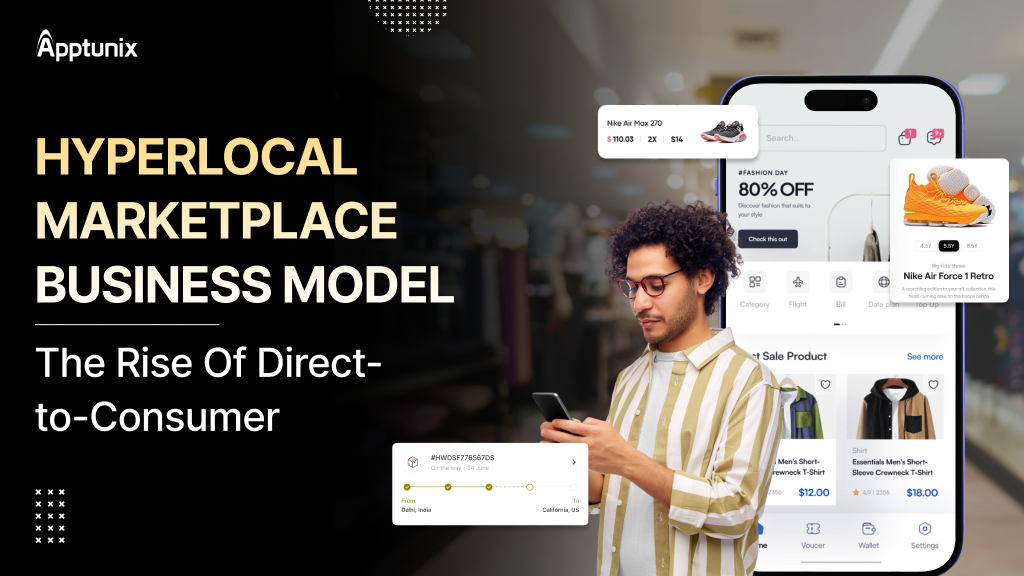
Ever since on demand market and the hyperlocal marketplace have been discovered, it has been in the buzz. Everyone is eager to know what it is all about and how the model can be implemented in their business. Don’t worry, this blog will help you know everything about the hyperlocal marketplace.
The reason behind this hype is pretty clear. The hyperlocal delivery model has proven to offer a lot of efficiency and convenience to both parties – sellers and buyers. Delivering products in a short time is the key to customer satisfaction. This is what is making the hyperlocal marketplace model popular.
This model is known to bring a lot of opportunities to small business owners. Hence, if own a business, read further and implement this model to increase your business growth and profitability.

The true meaning of a hyperlocal marketplace business is being local in your industry. It can also be described as an online business using the services of offline stores to meet the needs of customers on demand. This will all be done through an online platform.
The popular industries of the market, like food, laundry, grocery, etc., are some of the examples of businesses that follow the hyperlocal marketplace business model.
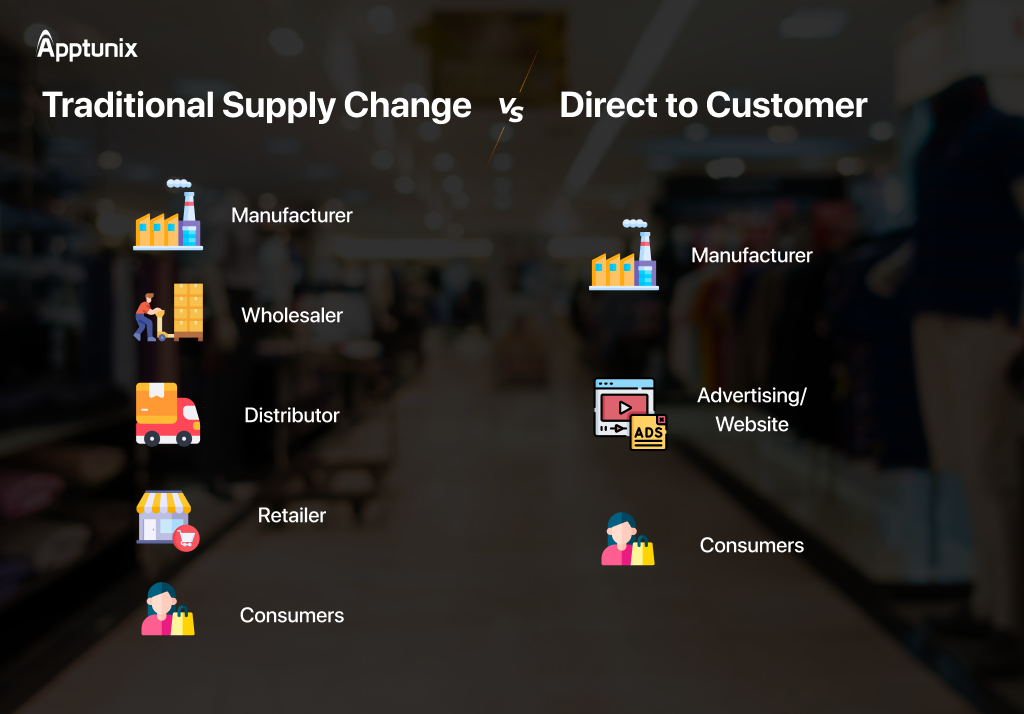
Features like geo-mapping in the business model have paved the way for businesses to expand post-pandemic. This is also a reason why this marketplace is flourishing. It is no news that understanding, proximity, and belief lead to customer satisfaction.
The hyperlocal business model brings sellers close to the customers. It plays on the customer’s expectation of being properly serviced. They receive their requested product/service in a matter of hours. Customer satisfaction may be obtained with little effort and expense.
Sellers/merchants, on the other hand, find it quite simple to cater to and deliver a geographically close client. Merchants understand their clients’ aesthetics and may tailor their business strategies appropriately. Costs are reduced significantly at the end of both the aggregator and the merchant, resulting in a win-win approach for both.
D2C or Direct-to-consumer is a marketing technique that can be defined as selling products directly to the customers without the involvement of any third party, wholesalers, or others. Many business owners are moving their business D2C because of the following reasons:
Any vendor or manufacturer who wants to sell their products directly to their consumers can set up an online platform under a direct-to-consumer (D2C) paradigm. They may advertise it on a variety of social media channels, cutting out the middlemen.
The success of a hyperlocal marketplace business model heavily depends on robust mobile application development, as it forms the bridge between vendors, customers, and administrators. Below are the essential features categorized for smooth operations.
1: Admin FeaturesThe admin panel is the central control hub, giving you full visibility and authority over platform activities. It enables streamlined operations, reporting, and customer-vendor management. Key features include:
2: Vendor FeaturesVendors are the backbone of a hyperlocal marketplace. Their features should simplify product listing and ensure seamless communication with customers. Some must-have features are:
3: Customer FeaturesCustomers expect convenience and reliability in every transaction. The mobile app must offer a smooth user experience to drive engagement. Key features include:
Selling your products will generate higher revenues and increase customer traction. But these are not the only benefits. Some other notable advantages of moving your business D2C are mentioned below:
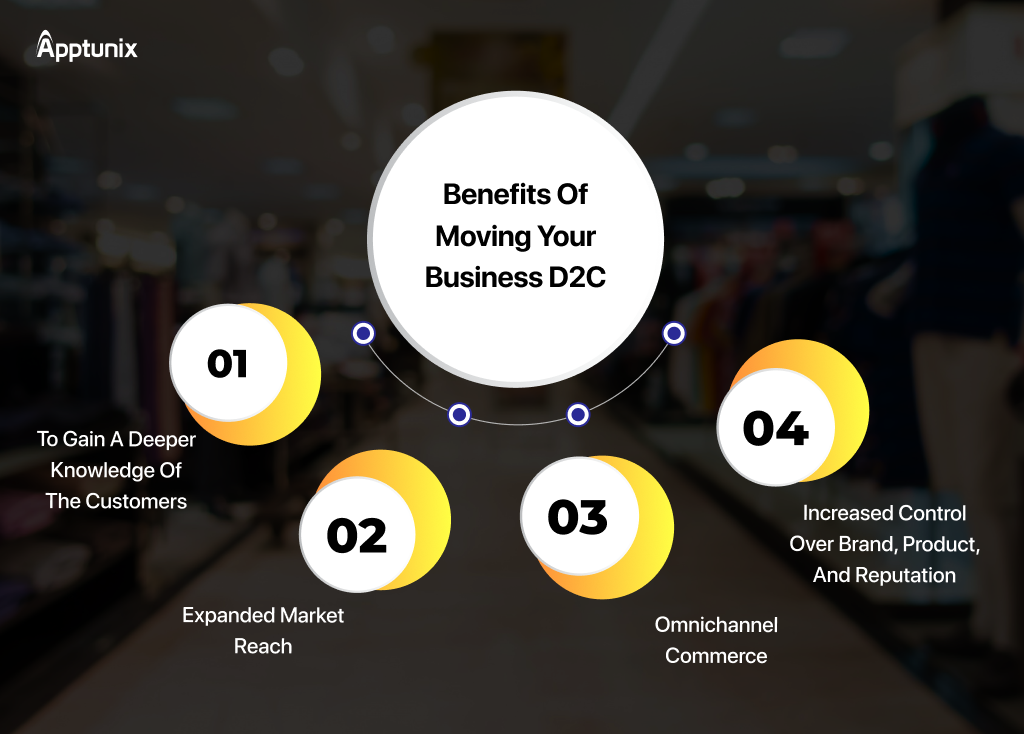
1: Gain Knowledge About CustomersWith the help of a hyperlocal marketplace business model, your brand will be able to interact with your customers at every step of the sales funnel. Furthermore, businesses may successfully communicate long after the product has been sold. As a result, businesses may have a deeper understanding of their target market.
2: Expand Market ReachD2C allows companies to reduce risks by allowing them to launch a new innovative product on a smaller scale. DTC businesses may create a specific product, test it on a very narrow population, and then receive feedback. This allows major manufacturing companies to learn what their customers like and dislike about their products, allowing them to make the necessary changes when necessary.
3: Increased Reputation, Services & BusinessD2C hyperlocal companies may be transparent with their consumers while also maintaining their reputation, brand image, and product. Companies have total control over their brand from the moment a client initiates contact with them until the product is purchased.
4: Omnichannel eCommerceAnother advantage of selling directly to consumers is the possibility of multichannel delivery. Brands may utilise a headless commerce platform to create an online store. Customers will be able to explore and buy across various channels, as well as select from several delivery choices, as a consequence.
The marketplace that caters to the demand of consumers in a small geographic area is known as a hyperlocal marketplace. Saying no to moving hyperlocal will be a big mistake in 2021-22. This model has proven to be efficient, convenient, and cost-effective. The geo-location feature, on-time supply, safety, and convenience are all critical components in the success of the hyperlocal marketplace.
After the outbreak of COVID-19, everyone is facing difficulties in their business and lifestyle. The comfort that we used to have before cannot be expected soon. The demand for food delivery, grocery delivery, or any other service is increasing gradually.
It is frequently used since it connects buyers with vendors who are nearby. It translates the customer’s desire to be well-served. They get their goods or services ordered within a few hours.
Satisfaction is obtained with little effort and money. Merchants, on the other hand, find it very easy to cater to and deliver to a consumer who lives nearby. Merchants are aware of the aesthetic preferences of their customers and may adjust their business models appropriately. Finally, both the aggregator and the merchant save money, making this a win-win situation for both.
As a result, a hyperlocal marketplace is a fantastic method to expand your reach inside a narrow geographical area. To make goods more available to your target demographic, you may collaborate with local store owners and small e-commerce firms.
Recently, there has been a surge in the need for simplifying your digital presence with a strong platform that allows direct-to-consumer sales. So, instead of falling behind, create your D2C hyperlocal marketplace now and enter the game with your unique ideas to lead the industry transformation.
Apptunix will help your brand reach out to your customers with a more personalized approach. We offer multiple features like branch management, geofencing, location tracking, improving brand visibility, and many more.
We can also help your business with a hyperlocal marketplace business model to make sure you target the right audience and deliver services to them at the right time.
Let me tell you the benefits of getting a hyperlocal marketplace solution from Apptunix:
1: Enhanced Customer ServiceTo optimise the customer experience, Apptunix delivers a mobile-friendly website as well as specialised Android and iOS applications for your marketplace. Bots and live chat are available 24 hours a day, seven days a week, to help your suppliers.
Thanks to geofencing, you may track the end user’s location and offer them items accordingly. End users may search the marketplace using keywords, dates, and categories. They may sort the results by price, name, and rating.
You’ll also get access to a comprehensive rating and review system for keeping track of what buyers think about the product. With a choice of free themes, you can make your marketplace seem upscale and world-class.
2: Improved OperationsUsing Apptunix’s merchant applications, your merchants will be able to rapidly fulfil orders, manage inventory, and update their store. Apptunix provides real-time tracking as well as the ability to regulate routes and timetables all in one place to ensure that the goods are delivered on time.
You can manage your meta-tags, viewable sitemap, and robots.txt files in a flash. We will monitor your website regularly to guarantee that there are no outages in the hosting. There will be no restrictions on the number of users, traffic, listings, or photos.
3: Improved SecurityTo make your marketplace a secure environment for end-users, Apptunix provides you with a marketplace where you may pick your merchants only by invitation. We will also offer you an SSL certificate to safeguard your data and that of your clients.
A manufacturer that is looking to enter the direct-to-consumer market needs a solid strategy to succeed. Now, the best way to design a strategy is by breaking it down into smaller parts so that there is no chance for errors.
Now, let’s do just that!
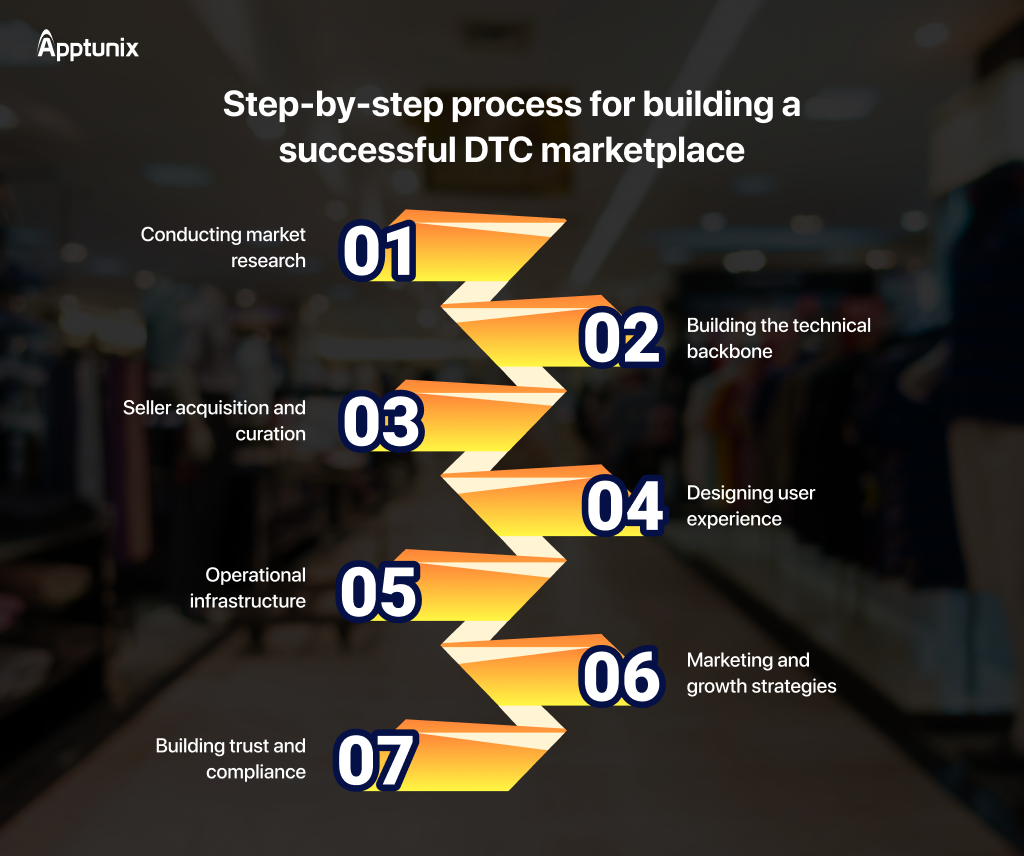
Step 1: Conducting market researchBefore moving into D2C, manufacturers need to clearly identify why they are making the shift. Without clarity, execution will lack direction.
Ask yourself:
Once you define these objectives, you can design a roadmap that directly aligns with your goals.
Step 2: Building the technical backboneThe backbone of your marketplace is its technology. A strong backend is key to ensuring everything runs smoothly, can grow with demand, and stays secure. This means picking the right tech stack, setting up databases, integrating APIs for payments and logistics, and implementing solid cybersecurity measures.
Plus, being mobile-friendly and having a reliable cloud infrastructure are crucial for managing high traffic. At Apptunix, we’re all about building an architecture that strikes the perfect balance between speed, flexibility, and long-term growth.
Step 3: Seller acquisition and curationTo build a thriving D2C marketplace, you must carefully curate the right set of sellers instead of just onboarding anyone.
Start by identifying the kind of sellers that align with your brand promise and the expectations of your target customers. This will help you maintain product quality and consistency across your marketplace.
Look at industry benchmarks, competitor platforms, and seller performance reports in your niche. Analyze what kind of vendors are driving the most sales and customer trust, then position your marketplace to attract similar high-value sellers.
Once you’ve done your research, focus on building a streamlined seller onboarding process.
Use performance analytics to track seller metrics like order fulfillment rate, customer reviews, and return rates. This will help you reward top sellers while identifying and addressing underperforming vendors quickly.
Incorporating AI-powered insights can further optimize your marketplace by matching customers with the most relevant sellers and products.
Step 4: Designing user experienceThe customer journey should be smooth and effortless, starting from the moment someone browses products all the way to checkout. This involves having easy navigation, robust search features, personalized suggestions, and a hassle-free payment process.
Good UI/UX design is essential for making sure users enjoy the platform, come back often, and share their experiences with others. Our marketplace app development company focuses on crafting user-friendly interfaces that combine simplicity with functionality.
Step 5: Operational infrastructureEvery great customer experience is supported by a solid operational foundation. This involves everything from managing orders and tracking inventory to handling logistics and returns. By teaming up with trustworthy logistics partners and using automated inventory tools, you can boost efficiency and cut down on delays. Our marketplace app developers specialize in helping you optimize these processes with tailored solutions that grow alongside your business.
Step 6: Marketing and growth strategiesEven the best-designed platform can hit a wall without a solid marketing strategy. Whether it’s through digital ads, SEO, influencer collaborations, or loyalty programs, your approach should aim at not just bringing in new customers but also keeping the ones you already have. Leveraging data-driven insights and analytics is key to fine-tuning your campaigns and reaching the right audience.
Apptunix is here to help you integrate cutting-edge analytics and marketing automation to boost your ROI.
Step 7: Building trust and complianceConsumers today are highly aware of data privacy, online scams, and counterfeit products. If they do not feel secure while interacting with your brand, they will simply move to a competitor. That’s why building trust and ensuring compliance is not just a legal requirement but a growth enabler.
Key elements to focus on:
By prioritizing trust and compliance, manufacturers strengthen customer loyalty and create a safe, reliable shopping environment that encourages repeat purchases.
The on demand near me hyperlocal marketplace industry is dominated by five primary industries. The marketplace’s business is expanding, and many sectors are making use of the hyperlocal marketplace.
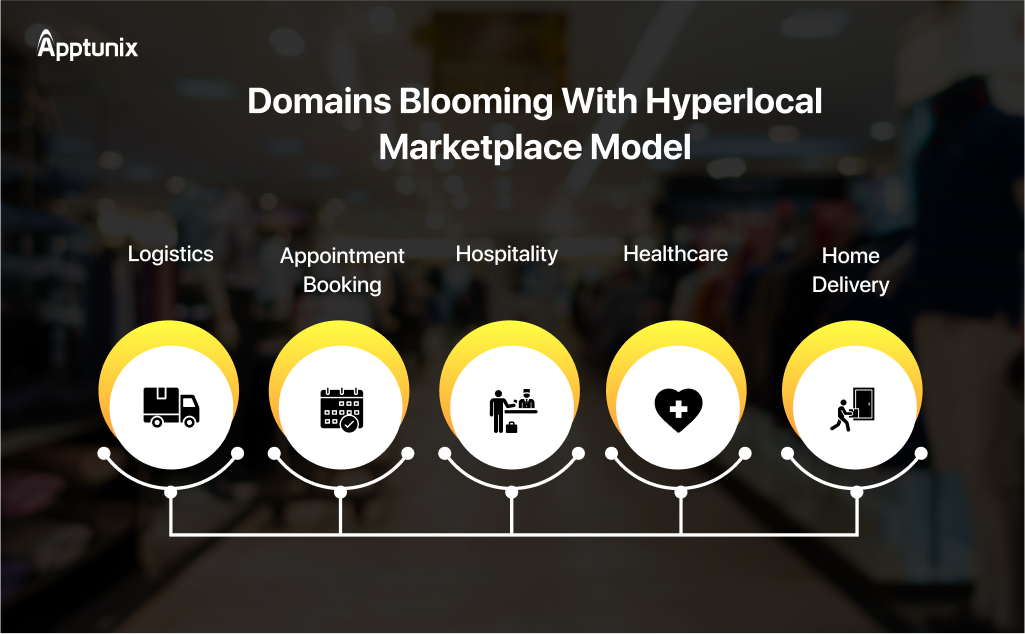
1: Delivery of Consumer GoodsFast-moving consumer goods, often known as consumer packaged goods, are high-demand items that sell rapidly. Top hyperlocal marketplace firms include groceries, packaged items, dairy products, medications, and so on.
Amazon Grocery is a famous grocery delivery service in India. It is growing in popularity, and individuals in cities are choosing it. BigBasket and Grofers are the top leaders in India’s grocery sector. Following COVID-19, delivery applications have grown increasingly popular, and people are eager to take advantage of food and groceries home delivery services to escape crowds.
Local sellers have a wonderful opportunity to shine in the shadows right now.
2: Appointment BookingThe transportation business is propelling the on-demand industry. Cab services such as Ola and Uber are the market leaders. They provide meal delivery, ridesharing, and other services.
Other Hyperlocal Marketplace booking firms include dinner reservations, movie ticket reservations, BookMyShow– movie ticket reservations, Dine Out– restaurant table reservations, and Dine Out even gives discounts and promotions to consumers.
MakeMyTrip is another famous website for hotel bookings, purchasing flight tickets, or planning a vacation, and there are many more excellent companies in the industry that are thriving.
3: Hospitality ServicesLocal company owners who offer on-demand services are excited about the prospect of developing a hyperlocal marketplace. Housekeeping, beauty salons, Spa & Massage, and dog care services are becoming increasingly popular. Urban Clap is a hyperlocal marketplace for on-demand services.
Other companies for the hyperlocal marketplace include appliance repair, electricians, mobile services, technicians, carpenters, house cleaning or pest control, packers and movers, and plumbers. Another popular app for on-demand delivery services is UrbanHopperz.
4: Health ServicesFollowing the epidemic, the healthcare business is receiving far more attention than previously. After COVID-19, health care services, nurses, baby care, and old age health care must all be provided. Given the scarcity of hospital beds, the need for home health care services is growing.
Because developing nations are unable to offer the necessary amenities in hospitals, a home caregiver or nurse is the best alternative. In hyperlocal marketplace enterprises, the healthcare industry has a large reach.
5: LogisticsPeople usually go into the hotel industry. Near-me hyperlocal on-demand services are constantly developing. It comprises logistics or concierge, which is becoming more popular in metropolitan areas. Such services are used by people to mail documents or lunch boxes.
Some of the popular startups providing on-demand concierge services include Dunzo, a mobile-based concierge services provider in India, Fetchr, which is popular in Dubai for booking delivery services, Alfred Club, which is based in the United States and provides an ‘Alfred’ to households to handle their weekly errands, and many more.
Pidge is a company in Delhi NCR that provides 60-minute pick-up and quick delivery.
A hyperlocal delivery system may be done with anything, such as taxis, automobiles, bikes, or public transportation, and it can happen with anything, such as car service, groceries, food, and so on. Today, the majority of hyperlocal delivery methods are just-in-time.
Building relationships with other merchants and delivery providers, targeting the proper audience, and developing a fantastic mobile app all take time. However, all of these factors will provide your company with the competitive advantage it requires.
Our primary goal at Apptunix is to provide efficient and innovative e-commerce marketplace app development extensions so that your e-commerce experience is as seamless as possible. We can assist and support you with anything connected to e-commerce, whether you want to establish an online grocery shop, a food store, or a delivery app.

Q 1.What is DTC in ecommerce?
DTC, or Direct-to-Consumer, is a business model in the eCommerce world where brands or manufacturers sell their products straight to customers via their own digital platforms, like websites, mobile apps, or social media. The biggest perk of DTC is that it allows brands to have full control over the customer experience, pricing, and branding, all while gathering valuable data to tailor their offerings to individual preferences.
Q 2.What does direct-to-consumer mean?
Direct-to-consumer means that the brand directly interacts with and sells to the end customer without relying on middlemen. For example, instead of selling through big-box retailers, a clothing brand may sell through its website or app. This approach allows the company to have full control over product pricing.
Q 3.How is DTC different from retail?
Traditional retail typically involves multiple layers, like distributors, wholesalers, and retail stores, before the product reaches the consumer. This increases costs and dilutes brand-customer interaction. In contrast, DTC removes these intermediaries, allowing the brand to sell directly.
Q 4.Why is DTC growing?
DTC is growing rapidly due to multiple factors:
In fact, according to eMarketer, U.S. DTC eCommerce sales crossed $182 billion in 2023 and continue to rise globally.
Q 5.What role does SLC play in DTC?
Supply Chain Logistics plays a critical role in the success of a DTC business. Since customers expect fast and reliable deliveries (like next-day or 2-day fulfillment), brands must optimize their supply chain. This includes:
In short, a strong SLC ensures a seamless post-purchase experience, which is vital for customer satisfaction and repeat purchases in the DTC model.
Get the weekly updates on the newest brand stories, business models and technology right in your inbox.
Book your free consultation with us.
Book your free consultation with us.





